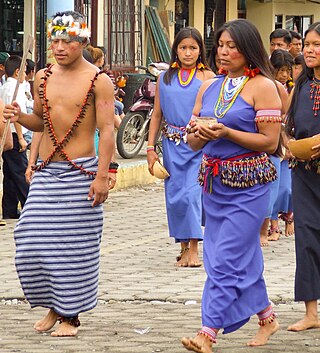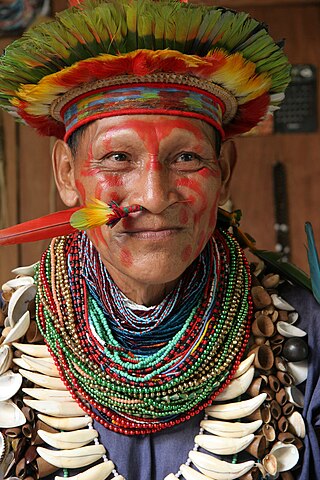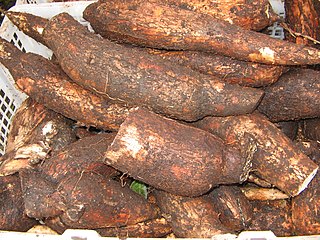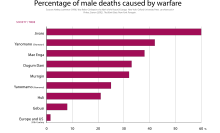
Ayahuasca is a South American psychoactive beverage, traditionally used by Indigenous cultures and folk healers in the Amazon and Orinoco basins for spiritual ceremonies, divination, and healing a variety of psychosomatic complaints.

Demographic features of the population of Ecuador include population density, ethnicity, education level, health of the populace, economic status, religious affiliations and other aspects of the population.
Jivaro or Jibaro, also spelled Hivaro or Hibaro, may refer to:

A shrunken head is a severed and specially-prepared human head – often decreased to many times smaller than typical size – that is used for trophy, ritual, trade, or other purposes.

The Shuar, also known as Jivaro, are an indigenous ethnic group that inhabits the Ecuadorian and Peruvian Amazonia. They are famous for their hunting skills and their tradition of head shrinking, known as Tzantsa.
Neoshamanism, refers to new forms of shamanism, where it usually means shamanism practiced by Western people as a type of New Age spirituality, without a connection to traditional shamanic societies. It is sometimes also used for modern shamanic rituals and practices which, although they have some connection to the traditional societies in which they originated, have been adapted somehow to modern circumstances. This can include "shamanic" rituals performed as an exhibition, either on stage or for shamanic tourism, as well as modern derivations of traditional systems that incorporate new technology and worldviews.

The Achuar are an indigenous people of the Americas belonging to the Jivaroan family, alongside the Shuar, Shiwiar, Awajun, and Wampis (Perú). They are settled along the banks of the Pastaza River, Huasaga River, and on the borders between Ecuador and Perú. The word "Achuar" originates from the name of the large palm trees called "Achu" that are abundant in the swamps within their territory.

The Chicham languages, also known as Jivaroan is a small language family of northern Peru and eastern Ecuador.
Shuar, which literally means "people", also known by such terms as Chiwaro, Jibaro, Jivaro, or Xivaro, is an indigenous language spoken by the Shuar people of Morona Santiago Province and Pastaza Province in the Ecuadorian Amazon basin.

The Aguaruna are an indigenous people of the Peruvian Amazon-Andes divide. They live primarily on the Marañón River in northern Peru near the border with Ecuador and several of the Marañón's tributaries, the rivers Santiago, Nieva, Cenepa, Numpatakay and Chiriaco. Currently, they possess titled community lands in four of Peru's regions: Amazonas, Cajamarca, Loreto, and San Martín. A significant Awajún population also lives in the Alto Mayo river basin in the Department of San Martín. According to Peru's 1993 Census the Aguaruna numbered approximately 5,000. World Census data for 2000 lists their population at just over 8,000.
Huambisa, Huambiza, Wambiza, Jíbaro, Xívaro, Wampis, Maina, or Shuar-Huampis is an indigenous language of the Huambisa people of Peru. Spanish colonizers first generated the name Xívaro in the late 16th century as a way of overgeneralizing several ethnicities of similar sociopolitical statuses within the region and referring to them as savages. It is an established language spoken in the extreme north of Peru. It is closely related to the Achuar-Shiwiar, Shuar, and Aguaruna languages, all of which belong to the Jivaroan language family. It has official standing in the area it is spoken.
Shiwiar, also known as Achuar, Jivaro and Maina, is a Chicham language spoken along the Pastaza and Bobonaza rivers in Ecuador. Shiwiar is one of the thirteen indigenous languages of Ecuador. All of these indigenous languages are endangered.

Michael James Harner was an American anthropologist, educator and author. His 1980 book, The Way of the Shaman: a Guide to Power and Healing, has been foundational in the development and popularization of core shamanism as a New Age path of personal development for adherents of neoshamanism. He also founded the Foundation for Shamanic Studies.

Amazonian Kichwas are a grouping of indigenous Kichwa peoples in the Ecuadorian Amazon, with minor groups across the borders of Colombia and Peru. Amazonian Kichwas consists of different ethnic peoples, including Napo Kichwa and Canelos Kichwa. There are approximately 419 organized communities of the Amazonian Kichwas. The basic socio-political unit is the ayllu. The ayllus in turn constitute territorial clans, based on common ancestry. Unlike other subgroups, the Napo Kichwa maintain less ethnic duality of acculturated natives or Christians.
Vegetalismo is a term used to refer to a practice of mestizo shamanism in the Peruvian Amazon in which the shamans—known as vegetalistas—are said to gain their knowledge and power to cure from the vegetales, or plants of the region. Many believe to receive their knowledge from ingesting the hallucinogenic, emetic brew ayahuasca.

The Marañón River basin, at a low point in the Andes which made it an attractive location for trade between the Inca Empire and the Amazon basin, once harbored numerous languages which have been poorly attested or not attested at all. Those of the middle reaches of the river, above the Amazon basin, were replaced in historical times by Aguaruna, a Jivaroan language from the Amazon which is still spoken there. The languages further upriver are difficult to identify, due to lack of data. The region was multilingual at the time of the Conquest, and the people largely switched to Spanish rather than to Quechua, though Quechua also expanded during Colonial times.

Tsentsak are invisible pathogenic projectiles or magical darts utilized in indigenous and mestizo shamanic practices for the purposes of sorcery and healing throughout much the Amazon Basin. Anthropologists identify them as objects referenced in emic accounts that represent indigenous beliefs. Tsentak are not recognized in scientific medicine.
Tsunki is a name for the primordial spirit shaman within the Achuar and Shuar people of Amazonia. The term is derived from the Jivaroan language family. It translates to English as "the first shaman" and is frequently alluded to in shamanic songs.

Nihamanchï is a beer brewed from cassava by indigenous peoples of South America. It is also known as nihamanci, nijimanche, or nijiamanchi, and is related to chicha.
Shamanism is a religious practice present in various cultures and religions around the world. Shamanism takes on many different forms, which vary greatly by region and culture and are shaped by the distinct histories of its practitioners.

















